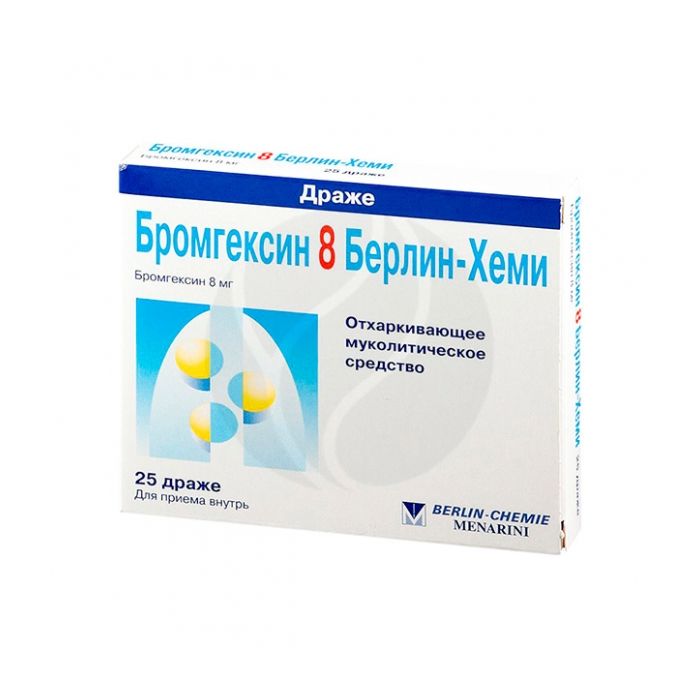Bromhexine 8 Berlin Chemie dragee 8mg, No. 25
Expiration Date: 05/2027
Russian Pharmacy name:
Бромгексин 8 Берлин Хеми драже 8мг, №25
Acute and chronic bronchopulmonary diseases, accompanied by the formation of sputum with increased viscosity
bronchial asthma,
pneumonia,
tracheobronchitis,
obstructive bronchitis,
bronchiectasis,
emphysema of the lungs,
cystic fibrosis,
tuberculosis,
pneumoconiosis.
Inside, adults and children over 14 years old - 8-16 mg 3 times a day; children under 14 years old and patients weighing less than 50 kg - 8 mg 3 times a day; children under 6 years old - 4 mg 3 times a day.
Dragee from yellow to greenish-yellow in color, biconvex, with an almost white core.
1 tablet bromhexine hydrochloride 8 mg
Excipients: lactose monohydrate - 34.4 mg, corn starch - 14.6 mg, gelatin - 1.8 mg, colloidal silicon dioxide - 0.6 mg, magnesium stearate - 0.6 mg.
Hypersensitivity to bromhexine and other components of the drug;
lactase deficiency, lactose intolerance, glucose-galactose malabsorption;
peptic ulcer of the stomach and duodenum (in the acute stage);
pregnancy (I trimester);
children under 6 years old
Pharmacodynamics
Bromhexine 8 Berlin-Chemie has a mucolytic (secretolytic) and expectorant (secretomotor) effect, as well as a weak antitussive effect. Reduces the viscosity of sputum, activates the ciliated epithelium, increases the volume of sputum and improves its discharge. Stimulates the production of endogenous surfactant, which ensures the stability of alveolar cells during respiration. The effect appears within 2-5 days from the start of treatment.
Pharmokinetics
When ingested, it is almost completely absorbed (99%) in the gastrointestinal tract (GIT) within 30 minutes. Bioavailability is about 80%. Binds to plasma proteins by 99%. Penetrates the placental and blood-brain barriers. Penetrates into breast milk. In the liver, it undergoes demethylation and oxidation, metabolized to ambroxol. The half-life is 15 hours (due to slow reverse diffusion from tissues). It is excreted by the kidneys in the form of metabolites. In chronic renal failure (CRF), the release of metabolites is impaired. May cumulate with repeated use.
Overdose
The life-threatening consequences of an overdose with Bromhexine 8 Berlin-Chemie are unknown.
The following symptoms are possible: nausea, vomiting, diarrhea, dyspeptic disorders
Side effects
Usually Bromhexine 8 Berlin-Chemie is well tolerated.
In rare cases, nausea, vomiting, dyspeptic symptoms, exacerbation of gastric ulcer and duodenal ulcer, allergic reactions (skin rash, rhinitis, edema), shortness of breath, fever and chills are possible.
Extremely rare - severe anaphylactic shock.
Headache, dizziness.
Increased activity of 'hepatic' transaminases (extremely rare).
For all forms of allergic reactions, you must stop taking this drug and inform your doctor about it.
Special conditions
In cases of impaired bronchial motility or with a significant amount of sputum secreted, the use of Bromhexin 8 Berlin-Chemie requires caution, due to the risk of delayed secretion in the airways.
In the course of treatment, it is recommended to consume a sufficient amount of liquid, which increases the secretolytic effect of bromhexine.
In severe renal failure, it is necessary to take into account the possibility of cumulation of metabolites formed in the liver.
In children, treatment should be combined with postural drainage or vibration massage of the chest, facilitating the removal of secretions from the bronchi.
The effect of the drug on the ability to drive vehicles and control mechanisms
During the period of treatment, care must be taken when driving vehicles and engaging in other potentially hazardous activities that require increased concentration of attention and speed of psychomotor reactions.
Drug interactions
Bromhexine is not prescribed concurrently with drugs that suppress the cough center (including those containing codeine), because this makes it difficult to evacuate the liquefied sputum.
Bromhexine promotes the penetration of antibiotics (erythromycin, cephalexin, oxytetracycline, ampicillin, amoxicillin) into the bronchial secretions in the first 4-5 days of antimicrobial therapy.
Not compatible with alkaline solutions.

